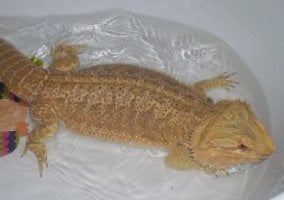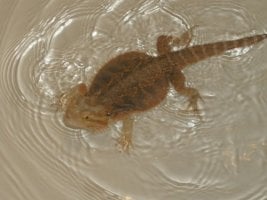General Do Bearded Dragons Need Baths? How Do I Bathe My Bearded Dragon?
- By Shinryu
While bearded dragons don't require baths, it is helpful to bathe them under certain circumstances. Some reasons why a bearded dragon might get a bath include the following:
- hydration (only if your bearded dragon prefers to drink bath water)
- hygiene
- easing a particularly uncomfortable shedding process
- easing constipation
- enjoyment of baths
If your bearded dragon doesn't like baths, just a few minutes to clean them off in the water is sufficient. Beardies who enjoy bathing can bathe for about 10-15 minutes. Never leave your bearded dragon unattended in a bath because they can aspirate water into the lungs or drown. While many beardies will drink from the bath, please, do not allow your beardie to submerge their head in the water.
It is essential to thoroughly dry your beardie after the bath to avoid any potential fungal problems from taking hold. After the bath, it's usually a good idea to let your bearded dragon bask for a while to warm up.
Now let's get into the specifics of why baths can be helpful or even necessary, at times, for bearded dragons.
Luckily, many bearded dragons will readily drink bath water, so bathing can help meet your beardie's water intake needs.
Thus, unlike their wild counterparts, pet bearded dragons need occasional baths if they step in their own excrement or track it throughout their enclosure.
Some bearded dragons can be messy eaters or consume particular fruit or berry that can stain their scales or leave a sticky residue. In those circumstances, it is advisable to bathe your bearded dragon to maintain cleanliness.
Of course, since animal husbandry practices vary significantly among bearded dragons owners, bearded dragons can develop "stuck shed" or feel itchy and uncomfortable during shedding (especially if they don't have any rougher surfaces in their enclosure for rubbing and loosening the shedding skin).
In these situations, bathing your beardie can prove beneficial and ease discomfort. Some bearded dragons enjoy it when their owners use a soft-bristled baby toothbrush to brush shedding skin during the bath. Using the soft toothbrush method while bathing your beardie can help loosen particularly stubborn old skin.
Adding a shed-ease product to the bath if your bearded dragon struggles with a particularly challenging or stubborn shed can also be beneficial. In these situations, it is always a good idea to review your husbandry practices to see if anything needs improvement since healthy bearded dragons can usually shed old skin without much intervention.
On rare occasions, a beardie may try to pass a particularly hard stool that gets stuck in the vent. In those cases, a warm bath can also help loosen everything up and allow the beardie to pass the stool safely. Please note that if your beardie experiences hard stools or dry/chalky urates, they are likely dehydrated.
If your bearded dragon poops in the bath, remove them immediately and replace the water before continuing the bath.
Many owners also enjoy bathing their beardies since it provides an excellent opportunity for bonding.
If your bearded dragon enjoys baths, it is ok to give them somewhat frequent baths but be sure to do just what is necessary. Too frequent bathing can dry out the skin, or if the bearded dragon is not thoroughly dried after each bath, it could lead to certain fungal diseases.
If your bearded dragon does not like baths and looks very uncomfortable or tries to escape the tub, only bathe them when necessary to keep them clean.
If you bathe your bearded dragon in the sink, be prepared that your dragon may try to escape the sink area and could fall onto the hard tile and hurt itself. This is especially true for bearded dragons who fear baths or hate the feeling of water. On the other hand, if your beardie is generally docile and at ease during bathing, they may not have an issue with being bathed in the sink.
Also, please be aware that most lizards will be afraid if you run the tap while they are in the sink or the tub and could seriously injure themselves in an attempt to escape from perceived danger.
Many bearded dragon owners choose to bathe their beardies in smaller containers --Tupperware for baby or young juvenile dragons, flat-bottomed baby tubs, turkey roasting pans, new/unused cat litter pans, plastic food storage bins, and other similarly-sized containers.
Suppose you bathe your bearded dragon for the first time and don't know how it will react. In that case, it is probably a good idea to set the container on the floor or a low table so that there is less potential for injury if they try to escape.
Since reptiles are cold-blooded, ensure the water doesn't get too cold. It is ok to scoop some cooled water out and add some warmer water back in (make sure it's not too warm).
If you must replace the water multiple times, your beardie's bath should be shorter. Usually, a ten-minute bath is sufficient for making sure your beardie is clean and has had a chance to drink some water.
Hydration
There is a common misconception that simply placing a bearded dragon into a bath for a while will help with hydration levels. However, bearded dragons cannot absorb water through their skin or vent. Thus, the only way a bath would aid hydration is if a bearded dragon chooses to drink the bath water.Luckily, many bearded dragons will readily drink bath water, so bathing can help meet your beardie's water intake needs.
Hygiene
Bearded dragons in the wild have a large area to roam and usually don't experience the same hygiene issues as those beardies who spend much of their time confined to a relatively small enclosure.Thus, unlike their wild counterparts, pet bearded dragons need occasional baths if they step in their own excrement or track it throughout their enclosure.
Some bearded dragons can be messy eaters or consume particular fruit or berry that can stain their scales or leave a sticky residue. In those circumstances, it is advisable to bathe your bearded dragon to maintain cleanliness.
Easing Difficult/Bothersome Shedding Process
While shedding is a natural process that all bearded dragons go through, shedding can be stressful and uncomfortable for beardies. However, healthy bearded dragons, raised with proper animal husbandry practices, typically don't require assistance with shedding.Of course, since animal husbandry practices vary significantly among bearded dragons owners, bearded dragons can develop "stuck shed" or feel itchy and uncomfortable during shedding (especially if they don't have any rougher surfaces in their enclosure for rubbing and loosening the shedding skin).
In these situations, bathing your beardie can prove beneficial and ease discomfort. Some bearded dragons enjoy it when their owners use a soft-bristled baby toothbrush to brush shedding skin during the bath. Using the soft toothbrush method while bathing your beardie can help loosen particularly stubborn old skin.
Adding a shed-ease product to the bath if your bearded dragon struggles with a particularly challenging or stubborn shed can also be beneficial. In these situations, it is always a good idea to review your husbandry practices to see if anything needs improvement since healthy bearded dragons can usually shed old skin without much intervention.
Easing Constipation
Warm water can help bearded dragons relax their muscles, and bearded dragons commonly poop directly in the bath. If your bearded dragon has been constipated, a warm bath can get things moving again, especially when combined with certain foods such as plain canned pumpkin.On rare occasions, a beardie may try to pass a particularly hard stool that gets stuck in the vent. In those cases, a warm bath can also help loosen everything up and allow the beardie to pass the stool safely. Please note that if your beardie experiences hard stools or dry/chalky urates, they are likely dehydrated.
If your bearded dragon poops in the bath, remove them immediately and replace the water before continuing the bath.
Enjoyment of Baths
Some bearded dragons enjoy soaking in the tub/basin or splashing/paddling around. Being in the water can be a stimulating sensory activity for some beardies.Many owners also enjoy bathing their beardies since it provides an excellent opportunity for bonding.
If your bearded dragon enjoys baths, it is ok to give them somewhat frequent baths but be sure to do just what is necessary. Too frequent bathing can dry out the skin, or if the bearded dragon is not thoroughly dried after each bath, it could lead to certain fungal diseases.
If your bearded dragon does not like baths and looks very uncomfortable or tries to escape the tub, only bathe them when necessary to keep them clean.
Other Tips for Bathing Your Bearded Dragon
Picking Where to Bathe Your Beardie
As stated earlier, you can bathe your beardie in anything that can hold water as long as the water level is shallow. However, if you choose to cleanse your bearded dragon in the same bathtub you use, be prepared to clean it beforehand to remove any soap and shampoo residue. You will likely have to clean it and sanitize it after your beardie's bath since many beardies will poop during the bath.If you bathe your bearded dragon in the sink, be prepared that your dragon may try to escape the sink area and could fall onto the hard tile and hurt itself. This is especially true for bearded dragons who fear baths or hate the feeling of water. On the other hand, if your beardie is generally docile and at ease during bathing, they may not have an issue with being bathed in the sink.
Also, please be aware that most lizards will be afraid if you run the tap while they are in the sink or the tub and could seriously injure themselves in an attempt to escape from perceived danger.
Many bearded dragon owners choose to bathe their beardies in smaller containers --Tupperware for baby or young juvenile dragons, flat-bottomed baby tubs, turkey roasting pans, new/unused cat litter pans, plastic food storage bins, and other similarly-sized containers.
Suppose you bathe your bearded dragon for the first time and don't know how it will react. In that case, it is probably a good idea to set the container on the floor or a low table so that there is less potential for injury if they try to escape.
Testing Bath Temperature
Always make sure to double-check the temperature of the water before placing your beardie inside. For example, you could use a thermometer or test the water by running it over the side of your wrist to ensure it feels slightly warm.Since reptiles are cold-blooded, ensure the water doesn't get too cold. It is ok to scoop some cooled water out and add some warmer water back in (make sure it's not too warm).
If you must replace the water multiple times, your beardie's bath should be shorter. Usually, a ten-minute bath is sufficient for making sure your beardie is clean and has had a chance to drink some water.
Finishing the Bath
After the bath, dry your bearded dragon thoroughly with a towel and encourage them to bask to warm up. Basking will help warm your beardie up and lessen the chances of any upper respiratory infections (URIs).
Display on Homepage :
- Enabled
Attachments
Last edited:





